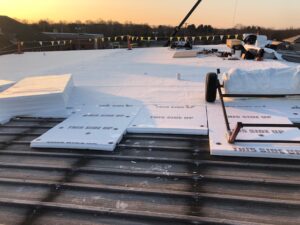A commercial roof protects your business infrastructure, but like every other thing, it experiences wear and tear. Common issues include leaks, pooling water, punctures, blistering, and shrinkage. These problems, if left unattended, can lead to significant damage. The pivotal question for many business owners is whether to repair or replace their commercial roof. A cost-benefit analysis can be a great tool when determining which commercial roofing services are right for you.
Understanding Cost-Benefit Analysis:
Cost-benefit analysis is a systematic approach for comparing the advantages and disadvantages of different courses of action. It involves evaluating all the potential costs and revenues that would be generated over the lifespan of a project. For a commercial roof, this means considering the costs of different commercial roofing services against the benefits each option would provide.

Repairing vs. Replacing Your Commercial Roof:
The cost of repairing a commercial roof may initially seem more appealing due to its lower upfront costs. However, continuous small repairs can add up over time and could end up being more expensive than a full replacement. For instance, if your commercial roof has minor leaks that are localized to one area, a commercial roof repair might be a cost-effective solution. But if the roof is showing signs of considerable aging and damage, a full replacement might be the more financially sound choice in the long run.
On the other hand, replacing a commercial roof involves a higher initial cost but can offer greater value over time. A new roof can last up to 25 years or more, depending on the materials used and the quality of installation. Moreover, new roofs often come with warranties, providing peace of mind and protection against future repair costs.
Risk and Reward:
There are potential risks and rewards associated with both options. Repairs carry the risk of recurring issues, especially if the underlying cause of the problem isn’t addressed. However, they can be a quick and cost-effective solution for minor roof issues.
Replacement eliminates all existing roof problems but comes with a higher upfront cost. The reward is a brand-new roof that could improve energy efficiency, increase property value, and reduce maintenance costs.
Real-Life Example:
Consider Company A, which chose to continually repair their aging roof. Over five years, they spent $70,000 on various repairs. On the other hand, Company B opted for a full roof replacement at a cost of $100,000. Although Company B paid more upfront, they saved on repair costs and reduced their energy bills by 20%, thanks to the improved insulation of the new roof.
The decision to repair or replace your commercial roof should not be taken lightly. A cost-benefit analysis can help you weigh the pros and cons of each option. While repairing may be a suitable short-term solution, replacing might offer better value in the long run. Ultimately, the best option depends on the specific circumstances of your commercial roof, your budget, and your long-term plans for your property. Consulting with a roofing professional can also provide valuable insights to help you make the most cost-effective decision for your business.